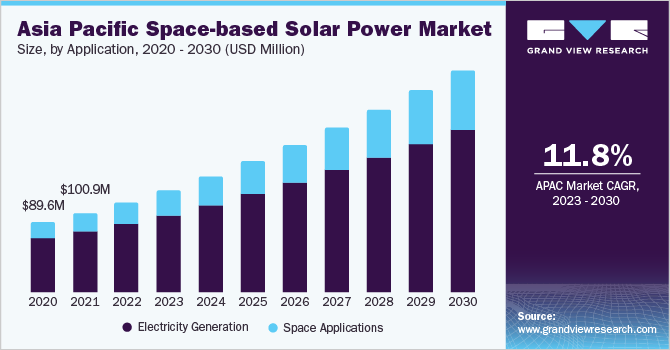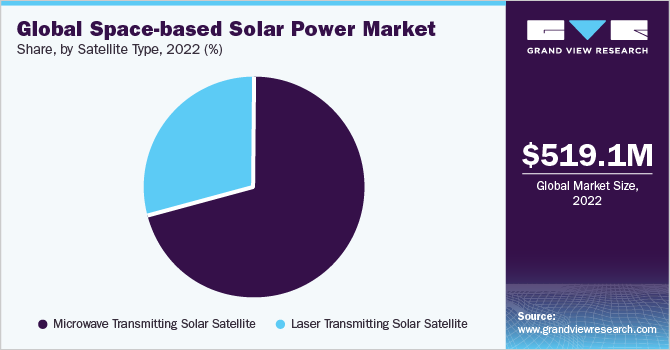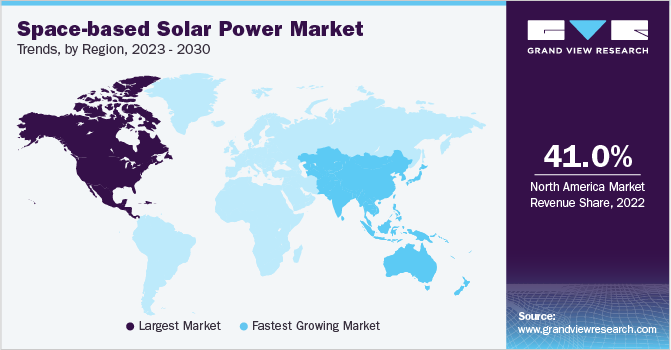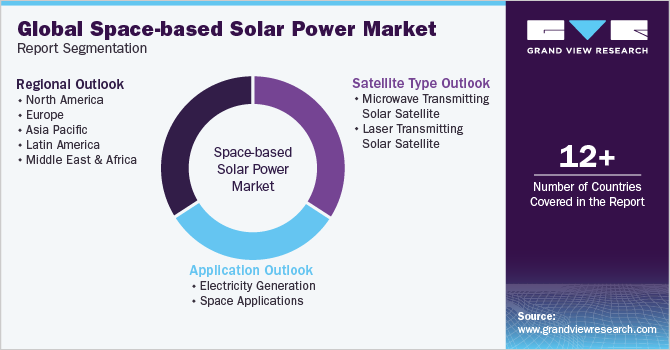
Space-based Solar Power Market Size, Share & Trends Analysis Report By Satellite Type (Microwave Transmitting Solar Satellite, Laser Transmitting Solar Satellite), By Application, By Region, And Segment Forecasts, 2023 - 2030
- Report ID: GVR-4-68040-101-2
- Number of Pages: 100
- Format: Electronic (PDF)
- Historical Range: 2017 - 2021
- Industry:Technology
Report Overview
The globalspace-based solar power market sizewas estimated atUSD 519.1 million in 2022and is expected to grow at a compound annual growth rate (CAGR) of 9.1% from 2023 to 2030. Space-based solar power involves extracting solar energy in space using solar power satellites and transmitting it to receiving stations on Earth. The energy collected from space can be utilized for various purposes, including electricity generation and powering space infrastructure. It plays a crucial role in powering space vehicles, satellites, rovers, and other space infrastructure. By utilizing solar energy from space, these systems can operate for extended durations without frequent refueling or relying on limited onboard energy sources.

The development of reusable rockets, such as SpaceX's Falcon 9, has significantly lowered the expense of launching equipment into space. By landing and refurbishing rockets for future launches, the expenses associated with accessing space have been reduced, making it more economically viable to deploy and maintain space-based solar power infrastructure. The use of robotics and automation in space missions has also played a crucial role in reducing costs and increasing operational efficiency. Robotic systems can perform maintenance and repair tasks on space-based infrastructure, minimizing the need for human intervention and associated costs.
Automation helps streamline operations, improve reliability, and potentially lower the overall expenses of space-based solar power systems. These advancements inspace technologyalong with the growing demand for sustainable and clean energy solutions, are driving the interest and potential market expansion of space-based solar power. As the global focus on sustainable technologies increases, space-based solar power systems present an attractive option for meeting energy needs while reducing reliance on fossil fuels and minimizing environmental impact.
Application Insights
The electricity generation segment held the largest revenue share of over 74% in 2022 owing to a rise in energy demand and cleaner generation of electricity in various industry verticals. Space-based solar power systems can capture solar energy directly in space without the limitations posed by weather conditions or the earth's rotation. This provides a virtually unlimited and constant solar energy source, enabling continuous electricity generation. Furthermore, it can supply power to spacecraft and satellites, ensuring their operations and reducing the need for onboard fuel or limited energy storage. This enables longer missions, extended capabilities, and enhanced functionality for space-based technologies.
估计gro空间应用程序段w significantly over the forecast period. Space-based solar power can provide a continuous and reliable power source for satellites in space. Satellites require electricity to operate their systems, including communication, navigation, data collection, and scientific instruments. Space-based solar power systems ensure an uninterrupted power supply, reducing the reliance on onboard batteries or limited energy sources. Furthermore, these systems power various space infrastructures, including space habitats, stations, and research facilities. These structures need a reliable and constant energy source for communication, life support systems, experiments, and other activities. Space-based solar power can provide the necessary power for sustained space processes.
Satellite Type Insights
The microwave-transmitting solar satellite segment led the market in 2022 accounting for over 70% share of the global revenue. Microwave-transmitting solar satellites can be positioned in specific orbits that deliver stable and predictable positions relative to the Earth's surface. This allows for consistent and efficient solar energy capture without being impacted by atmospheric conditions or the Earth's rotation, ensuring a steady power supply. As the demand forrenewable energy苏的增长,一些国家正在寻求新的力量rces beyond Earth. For instance, in January 2023, Japan planned to launch solar panels into orbit and transmit the generated electricity to the ground using microwave beams. UK and China have previously expressed interest in developing this technology, and Japan is the latest to jump on board.

The laser-transmitting solar satellite segment is estimated to grow significantly over the forecast period. Laser-transmitting solar satellites supply power to satellites during periods of the eclipse when they are not directly exposed to sunlight. These satellites can also be employed to supply power to orbital transfer vehicles during their tasks. By beaming power from space, laser-transmitting solar satellites assist in fulfilling the energy needs of these vehicles, reducing the dependence on onboard energy sources. For instance, in June 2022, China planned to launch a solar power plant in space by 2028. The satellite intends to convert solar energy into electricity and then into lasers or microwaves that can be transmitted to different specified targets on Earth.
Regional Insights
北America dominated the market in 2022, accounting for over 41% share of the global revenue. The U.S. is a prominent market for space-based solar power in the region. Players, such as Northrop Grumman and Solaren Corporation, are actively involved in developing space-based solar power technology. The presence of key players in the U.S. is also a key factor driving the market growth in the region. In addition, the government in the region offers funds for research activities identifying the prospect of space-based solar power technology as a source of clean, renewable energy.

Asia Pacific is anticipated to register the fastest CAGR over the forecast period due to the increased investment and R&D in space-based solar power and the presence of a large customer base in the region. Furthermore, India and China have emerged as significant space missions and solar power generation hubs, propelling regional market growth. Furthermore, an increase in knowledge about solar energy and its advantages in harvesting solar power from space rather than earth-based solar power will likely boost market expansion in the Asia Pacific region during the forecast period.
Key Companies & Market Share Insights
Prominent firms have used product launches and developments, followed by expansions, mergers and acquisitions, contracts, agreements, partnerships, and collaborations as their primary business strategy to increase their market share. The companies have used various techniques to enhance market penetration and boost their position in the competitive industry. For instance, in January 2023, the California Institute of Technology, a private research university in Pasadena, California, announced the launch of the Space Solar Power Demonstrator (SSPD) into orbit. By wirelessly transmitting electricity over long distances, the project aims to provide power to areas that currently lack reliable access to electricity. Some prominent players in the global space-based solar power market include:
Airborne
AZUR SPACE Solar Power GmbH
Fralock LLC
Japan Aerospace Exploration Agency
北rop Grumman
Borrego Energy, LLC
Solaren Corporation
SpaceTech GmbH
Space Canada
DHV Technology
太空太阳能市场报告范围
Report Attribute |
Details |
Market size value in 2023 |
USD 573.6 million |
Revenue forecast in 2030 |
USD 1,053.8 million |
Growth Rate |
CAGR of 9.1% from 2023 to 2030 |
Base year for estimation |
2022 |
Historical data |
2017 - 2021 |
Forecast period |
2023 - 2030 |
Quantitative units |
Revenue in USD million, CAGR from 2023 to 2030 |
Report coverage |
Revenue forecast, company ranking, competitive landscape, growth factors, trends |
Segments covered |
Satellite type, application, region |
Regional scope |
北America; Europe; Asia Pacific; Latin America; MEA |
Country scope |
U.S.; Canada; UK; Germany; France; China; Japan; India; South Korea; Australia; Brazil; Mexico; Kingdom of Saudi Arabia (KSA); UAE; South Africa |
Key companies profiled |
Airborne; AZUR SPACE Solar Power GmbH; Fralock LLC; Japan Aerospace Exploration Agency; Northrop Grumman; Borrego Energy, LLC; Solaren Corporation; SpaceTech GmbH; Space Canada; DHV Technology |
Customization scope |
Free report customization (equivalent up to 8 analysts' working days) with purchase. Addition or alteration to country, regional & segment scope. |
Pricing and purchase options |
Avail customized purchase options to meet your exact research needs.Explore purchase options |
Global Space-based Solar Power Market Report Segmentation
这份报告预测收入增长并提供an analysis of the latest industry trends in each of the sub-segments from 2017 to 2030. For this study, Grand View Research has segmented the global space-based solar power market report based on satellite type, application, and region:

Satellite Type Outlook (Revenue, USD Million, 2017 - 2030)
Microwave Transmitting Solar Satellite
Laser Transmitting Solar Satellite
Application Outlook (Revenue, USD Million, 2017 - 2030)
Electricity Generation
Space Applications
Regional Outlook (Revenue, USDMillion, 2017 - 2030)
北America
U.S.
Canada
Europe
Germany
UK
France
Asia Pacific
China
Japan
India
South Korea
Australia
Latin America
Brazil
Mexico
Middle East and Africa (MEA)
Kingdom of Saudi Arabia
UAE
South Africa





